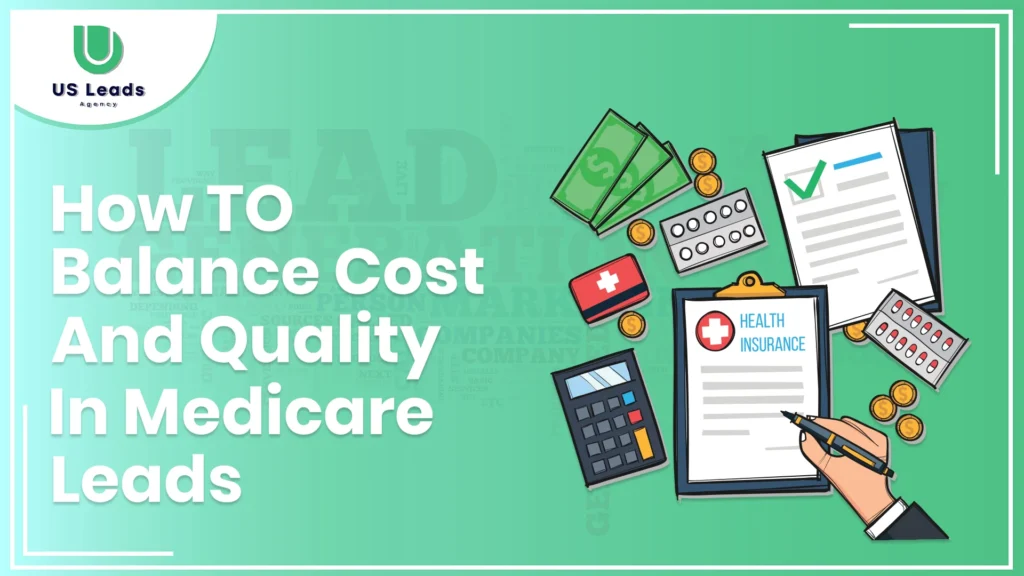
Balancing cost and quality in Medicare leads is a critical challenge for insurance agents and agencies aiming to maximize return on investment (ROI). In 2024, the Medicare landscape has evolved significantly, with approximately 67.3 million U.S. adults enrolled in Medicare, and 50.4% of these beneficiaries participating in Medicare Advantage plans. This growing market underscores the importance of effective lead generation strategies. However, the cost per Medicare lead can vary widely, ranging from $20 to $100, depending on the source and quality. Investing in high-quality leads is essential, as they are more likely to convert into clients, thereby enhancing ROI.
This article provides actionable strategies about how to balance cost and quality in medicare leads ensuring your investment in Medicare leads delivers maximum ROI.
Key Takeaways:
- High-quality leads may cost more but improve conversion rates.
- Organic strategies like SEO complement paid campaigns, optimizing costs long-term.
- Continuous monitoring of ROI and strategic adjustments ensure profitability.
- Building trust and nurturing relationships can maximize lifetime client value.
Table of Contents
What are Medicare leads?
Medicare leads refer to potential customers or individuals who have expressed interest in Medicare-related services or products, such as Medicare Advantage plans, Medicare Supplement plans, or Medicare Part D prescription drug plans. These leads are valuable to insurance agents, brokers, and agencies as they represent individuals who may be eligible for or are actively seeking Medicare insurance coverage.
Sources of Medicare Leads:
- Inbound Leads: Generated from people who contact an agency through online forms, website inquiries, or phone calls after seeing an ad or campaign.
- Outbound Leads: Collected through proactive efforts like cold calling, direct mail campaigns, or telemarketing.
- Purchased Leads: Acquired from lead generation companies that specialize in finding people interested in Medicare services.
- Referrals: Obtained from satisfied customers, healthcare providers, or community networks.
Characteristics of Good Medicare Leads:
- Accurate and Verified Information: Contact details like name, phone number, and email are correct.
- High Intent: The individual has shown genuine interest in learning more about Medicare plans.
- Timeliness: The lead is fresh, ensuring higher chances of conversion.
- Eligibility: The lead qualifies for Medicare based on age (65+) or other criteria such as disability.
Medicare leads are critical for agencies and brokers to grow their business, as they provide a targeted list of individuals who are likely to purchase Medicare-related products.
How To Balance Cost and Quality In Medicare Leads in 8 Simple Steps:
1. Understand Your Target Audience:
Before purchasing or generating leads, understanding your target audience is vital. Factors like age, location, income, and healthcare needs influence lead quality. While Medicare beneficiaries are typically 65 years or older, identifying subgroups such as those seeking Medicare Advantage or Supplement plans can help narrow your focus to high-quality leads, minimizing wasteful spending.
2. Choose The Right Lead Source:
The source of your Medicare leads significantly impacts both cost and quality. Here’s a breakdown of lead types:
- Exclusive Leads: Sold to one agent; high quality but expensive.
- Shared Leads: More affordable but involve greater competition.
- Organic Leads: Generated through efforts like SEO or social media; cost-effective long-term but time-intensive.
Evaluate lead providers based on reputation and transparency in generation methods to ensure value for your investment.
3. Implement Lead Scoring:
Lead scoring ranks leads based on conversion potential, enabling you to prioritize high-quality prospects. CRM tools automate this process, helping allocate resources effectively and maximize returns.
4. Leverage Automation For Cost-Effective Outreach:
Automation tools such as email platforms, chat bots, and auto-dialers streamline communication, reducing engagement costs while maintaining quality interactions. Automated follow-ups ensure no lead is overlooked.
5. Combine Paid and Organic Strategies:
A balanced approach includes both paid and organic methods:
- Paid Ads: Platforms like Google Ads quickly capture high-quality leads.
- Content Marketing: Blogs and guides organically attract leads over time.
This strategy ensures a steady lead flow without overburdening your budget.
6. Monitor and Optimize ROI:
Track metrics like cost per lead (CPL), conversion rate, and customer lifetime value (CLV) to evaluate campaign effectiveness. Regularly adjust strategies to focus on sources and methods delivering the best cost-quality balance.
7. Negotiate with Lead Providers:
Negotiate for bulk discounts or custom packages with lead providers. Look for refund or replacement policies for invalid leads to secure your investment.
8. Focus On Building Relationships:
Quality leads require nurturing. Build trust through follow-ups, clear communication, and personalized solutions. Even if a lead doesn’t convert immediately, strong relationship management can turn them into clients later.
Conclusion – How To Balance Cost and Quality In Medicare Leads:
Balancing cost and quality in Medicare leads is a dynamic yet essential aspect of achieving a successful insurance sales strategy. By understanding your target audience, carefully selecting lead sources, and implementing tools like lead scoring and automation, you can optimize both lead acquisition and conversion rates. A combination of paid and organic strategies, along with continuous ROI monitoring, ensures your efforts remain cost-effective and productive. Ultimately, focusing on building relationships and delivering personalized solutions can transform potential leads into loyal clients, creating long-term value for your business.
FAQs:
How can I ensure lead quality?
Focus on reputable lead providers, use lead scoring systems, and target specific subgroups within your audience.
Are organic leads better than paid leads?
Organic leads are cost-effective over time and build trust, but paid leads are quicker to generate, making both valuable in a balanced strategy.
How much does a Medicare lead cost?
Medicare lead costs vary widely, typically ranging from $20 to $100 per lead, depending on factors such as lead source, exclusivity, and quality.
